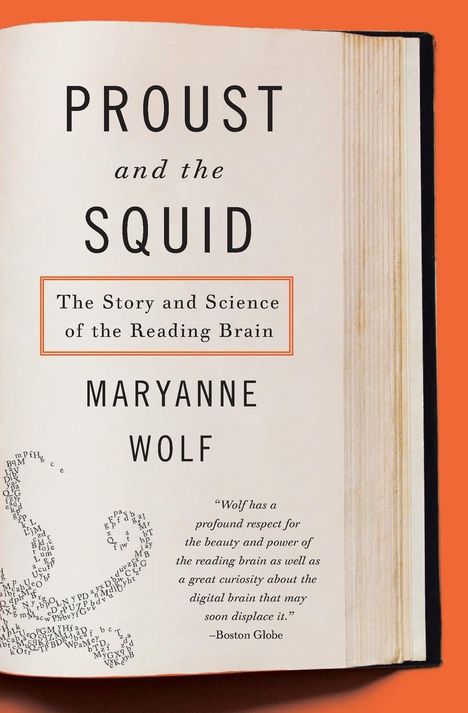Maryanne Wolf: Proust and the Squid: The Story and Science of the Reading Brain, Kartoniert / Broschiert
Proust and the Squid: The Story and Science of the Reading Brain
Buch
- The Story and Science of the Reading Brain
lieferbar innerhalb 2-3 Wochen
(soweit verfügbar beim Lieferanten)
(soweit verfügbar beim Lieferanten)
Aktueller Preis: EUR 21,98
- Verlag:
- Harper Perennial, 03/2020
- Einband:
- Kartoniert / Broschiert, Paperback
- Sprache:
- Englisch
- ISBN-13:
- 9780060933845
- Artikelnummer:
- 2160931
- Umfang:
- 336 Seiten
- Sonstiges:
- w. 28 b&w ill.
- Copyright-Jahr:
- 2008
- Gewicht:
- 281 g
- Maße:
- 194 x 143 mm
- Stärke:
- 22 mm
- Erscheinungstermin:
- 31.3.2020
- Hinweis
-
Achtung: Artikel ist nicht in deutscher Sprache!
Kurzbeschreibung
In the tradition of Stephen Pinker s The Language Instinct or Mel Levine s A Mind at a Time, a preeminent researcher known for her work in dyslexia offers an eloquent book about how the brain learned to read and in the process changed the way we as humans think.Beschreibung
Proust and the Squid is a remarkable tour de force by a world renown neuroscientist and reading expert. As the author explains, human beings were never born to read; we invented reading only a few thousand years ago. And with this invention, we changed the very organization of our brain, which in turn expanded the ways we were able to think, which altered the intellectual evolution of our species. Using a vivid and elegant multidisciplinary approach in the tradition of Jared Diamond or John McWhorter, she explains both the far-reaching effect that written language has had on human development as well as the extraordinarily complex cognitive and perceptual feat of learning to read and write. Ambitious, passionate, and creative, this book has the potential to become a classic of its kind.Maryanne Wolf began thinking about the brain in this way through her work with dyslexia, her academic specialty. As a research scientist she understands exactly what happens when a child is dyslexic, in other words, what happens when the brain can t read. From this starting point, she developed what is essentially an evolutionary look at the reading brain. As she asserts, the brain that examined the tiny clay tablets depicting a sheep, a goat, and two numbers in the proto-cuneiform script of the Sumerians is a very different brain than the one that is immersed in today s technology-driven literacy. In a very read sense, this bold book is an intellectual history that takes the reader from the brain of the oral tradition to the brain of the written traditon and now to the digital. Our reading brains are still evolving and the way that Wolf drives this thesis home makes for an explosive read.
Using neurology, sociology, psychology and philosophy, Wolf grounds her book in historical and scientific fact yet manages to anchor complicated ideas with down-to-earth examples and lively personal anecdotes. A book that challenges the way we see the world, or at least the printed page, this extraordinary blend of science and culture is erudite, fascinating, and memorable.
Klappentext
"Wolf restores our awe of the human brain--its adaptability, its creativity, and its ability to connect with other minds through a procession of silly squiggles." -- San Francisco ChronicleHow do people learn to read and write--and how has the development of these skills transformed the brain and the world itself ? Neuropsychologist and child development expert Maryann Wolf answers these questions in this ambitious and provocative book that chronicles the remarkable journey of written language not only throughout our evolution but also over the course of a single child's life, showing why a growing percentage have difficulty mastering these abilities.
With fascinating down-to-earth examples and lively personal anecdotes, Wolf asserts that the brain that examined the tiny clay tablets of the Sumerians is a very different brain from the one that is immersed in today's technology-driven literacy, in which visual images on the screen are paving the way for a reduced need for written language--with potentially profound consequences for our future.
Biografie
Maryanne Wolf leitet das Center for Reading and Language Research an der Tufts University. Die Professorin für kindliche Entwicklung arbeitet auf dem Gebiet der kognitiven Neurowissenschaften mit dem Forschungsschwerpunkt Dyslexie (Legasthenie) und ist eine Expertin für die Zusammenhänge zwischen Lesen und Gehirn.
Maryanne Wolf
Proust and the Squid: The Story and Science of the Reading Brain
Aktueller Preis: EUR 21,98

